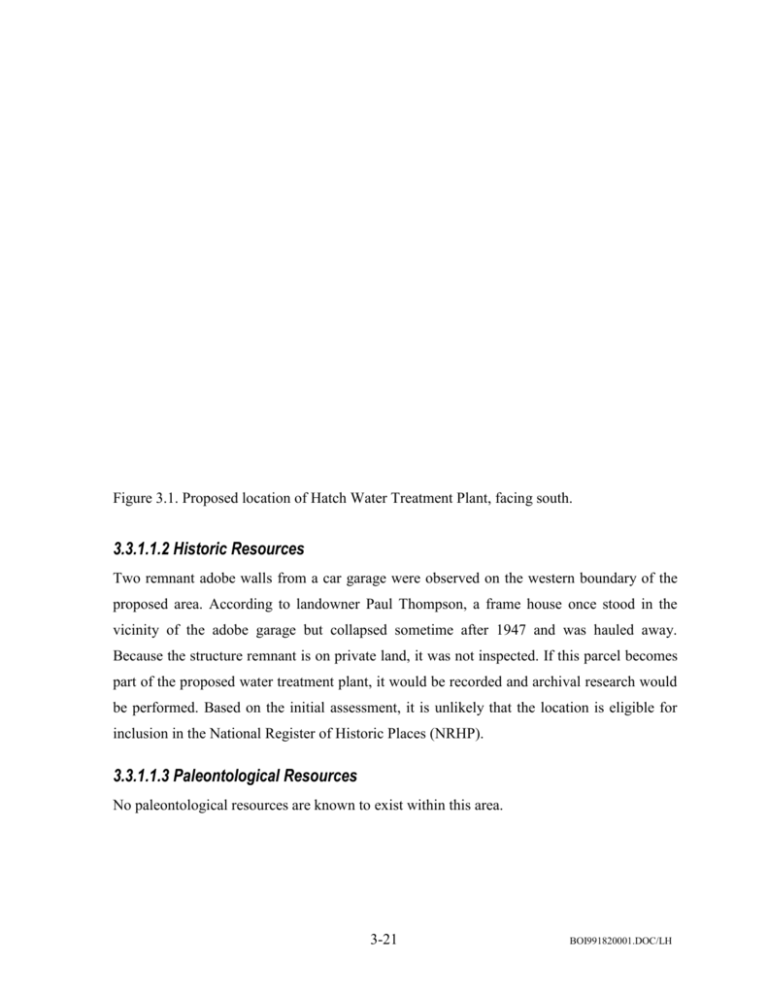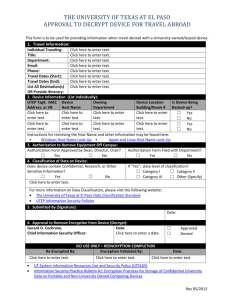photo-insert-pages - New Mexico
advertisement

Figure 3.1. Proposed location of Hatch Water Treatment Plant, facing south. 3.3.1.1.2 Historic Resources Two remnant adobe walls from a car garage were observed on the western boundary of the proposed area. According to landowner Paul Thompson, a frame house once stood in the vicinity of the adobe garage but collapsed sometime after 1947 and was hauled away. Because the structure remnant is on private land, it was not inspected. If this parcel becomes part of the proposed water treatment plant, it would be recorded and archival research would be performed. Based on the initial assessment, it is unlikely that the location is eligible for inclusion in the National Register of Historic Places (NRHP). 3.3.1.1.3 Paleontological Resources No paleontological resources are known to exist within this area. 3-21 BOI991820001.DOC/LH 3.3.1.2.1.1 Site LA 128798 Site Laboratory of Anthropology (LA) 128798 is a Formative period artifact scatter. The site is located approximately two miles southeast of the town of Radium Springs. The site is situated on a small hill overlooking the Rio Grande floodplain to the west at an elevation of 3,990 ft amsl (Appendix C). Two small southwest trending drainages are located to the north and south of the site. Vegetation on the site consists of creosote, mesquite, soaptree yucca, four-wing saltbush, prickly pear cactus, and a variety of ground forbs (Figure 3.2). Figure 3.2 Overview photograph of LA 128798. The 7,500 m2 site consists of an artifact scatter of over 100 artifacts, consisting of lithic debitage in all stages of reduction, El Paso brownware ceramics, and ground stone (mano fragments and a pounding stone). One Formative-style projectile point was also observed. A scatter of fire-cracked rock is scattered over the majority of the site, but no discrete features could be identified. Many naturally occurring river cobbles are also present on the site, indicating that one function of the site may have been a lithic acquisition area. Based on sand accumulation on portions of the site, the potential for subsurface deposits exists. Based 3-23 BOI991820001.DOC/LH Appendix C). The Anthony Water Treatment Plant is included in Alternatives A, B, and D. The raw water conveyance will connect to the New Mexico-Texas aqueduct either under Alternative D (described below) or from a diversion structure at the Rio Grande under Alternative A and B. The water will be piped to the local system. A new reservoir would be constructed to store treated water. The proposed Anthony Water Treatment Plant is located 2.5 miles south of Vado, New Mexico, on land owned by El Paso Natural Gas. A total of 76.5 acres was subjected to a Class III archaeological survey within the boundaries of the proposed treatment plant location. The area was composed of agricultural lands in the Rio Grande floodplain. No previously recorded archaeological sites are present within one mile of the survey area. Figure 3.3. Proposed location of Anthony Water Treatment Plant facing southeast. As part of the proposed Anthony Water Treatment Plant, treated water transmission lines must be constructed from the proposed plant location to the communities of La Mesa, Vado, Berino, Chamberino, and Anthony, New Mexico. Preliminary engineering planning information indicates these lines would be installed in existing rights-of-way along NM 28, BOI991820001.DOC/LH 3-26 Figure 3.4. House located within the boundaries of the proposed Upper Valley Water” Treatment Plant, facing east. 3.3.1.5.4 Ethnographic Resources No ethnographic resources are known to exist within this area. 3.3.1.6 Westside Regulating Reservoir (Alternatives D and E) The proposed action at this location is to construct a 22-acre regulating reservoir for water conveyance to the Upper Valley Water Treatment Plant under Alternative D or E, via the New Mexico-Texas Aqueduct (see Table 1.1, Map 1.1, and Appendix C). The proposed area is located west of the Rio Grande and is approximately 100 meters south of the Mesilla Diversion Dam. The area is situated along the edge of the Rio Grande, with sand ridges sloping upward to the west. A dense stand of salt cedar is located on the southeast portion of the proposed area. Approximately 75 acres were subjected to a Class III archaeological survey within the proposed location. One previously recorded site was located within the original area 3-29 BOI991820001.DOC/LH Figure 3.5. Site LA 854 showing borrow pit, facing northeast. The burial was removed and additional test excavation was conducted. A total of 264 artifacts was collected, including flaked stone, ground stone, bone, shell, burned rock, and brownware Mimbres boldface and redware ceramics. Etchieson describes the burial as “a male, approximately 35 years old. Burial goods included a brownware jar, a mano, and a brownware sherd ‘scoop’.” Radiocarbon analysis on the skeleton provided a date of 47090 A.D. (Etchieson 1987). Additional disturbance to site LA 854 was observed during this investigation. The southern locus, previously identified by Etchieson in 1987 as Knoll A, showed evidence of enlargement of a previously existing borrow pit as well as mechanical blading. Off-road vehicle activity has impacted all three loci. However, some portions of the site remain intact, particularly the upper slopes of Knolls B and C. El Paso brownware sherds, flakes, and ash stains are still present on the site. 3-31 BOI991820001.DOC/LH Figure 3.6. Proposed El Paso Aqueduct route facing south along El Paso Natural Gas pipeline road. Figure 3.7. Proposed El Paso Aqueduct route, facing west from the summit of Anthony Gap. 3-37 BOI991820001.DOC/LH There the pipeline turns south and follows the western side of the road between the road and the right-of-way fence, returning into Texas past the Newman Power Plant. Approximately one mile south of FM 2529, the pipeline turns due east for one mile, then turns south for one mile, then east 1.2 miles until meeting the boundary of Painted Dunes Golf Course (Figure 3.8). The pipeline turns south-southeast under US 54, through a greenbelt area. The pipeline then crosses under Dyer Street and into a ponding area. The final leg follows the western side of Railroad Drive to the existing Loop 375 Reservoir and Booster Pump Station. Figure 3.8. Proposed El Paso Aqueduct route, facing west near the Painted Dunes Golf Course. A Class III archaeological survey was conducted along the proposed aqueduct corridor. A 100-foot-wide corridor was inspected in all areas except where the corridor was restricted, such as between highways and right-of-way fences. Proposed booster pump station locations also were surveyed. The majority of the surveyed route could be clearly identified using USGS topographic maps. Because the survey area was not marked with flagging, one portion of the project corridor BOI991820001.DOC/LH 3-38 Figure 3.9. Site LA 127219, facing east. No features were observed on the site. Based on the limited assemblage and low potential for subsurface remains (shallow arroyo cuts, trowel test), this site is not considered eligible for inclusion in the NRHP. 3.3.2.2.1.2 Site 41EP14 Site 41EP14 is a large ceramic and lithic scatter with numerous fire-cracked rock features. The site is located immediately southwest of the Newman Power Plant in northeast El Paso (see Appendix C). Martin Luther King Boulevard bisects the site. It is located on the lower eastern alluvial fan of the Franklin Mountains with elevations ranging between 4,065 and 4,130 feet amsl. The site measures approximately 1,368,000 m2. Vegetation consists of creosote bush, Mormon tea, broom snakeweed, and various grasses. The site was originally recorded in the 1960s by the El Paso Archaeological Society when a burial was discovered and removed from an eroding wash. The area was revisited in 1979 3-41 BOI991820001.DOC/LH measures approximately 2,100 m2. Vegetation on the site includes creosote, cholla cactus, broom snakeweed, and grasses. Figure 3.10. Site 41EP2612, facing west showing greenbelt levee. Site 41EP2612 was originally recorded by the El Paso Archaeological Society between 1981 and 1983. The El Paso Centennial Museum updated the site in 1985 during the North/South Freeway and greenbelt survey (TARL files), and the last update was conducted by New Mexico State University (Miller 1987). Previous recording of 41EP2612 indicated that the site was a scatter of lithic and ceramic artifacts with two fire-cracked rock features. Ceramics on the site include Mimbres Black-on-white, El Paso Polychrome, El Paso Brown, Chupadero Black-on-white, and corrugated wares. Two mano fragments and flaked stone tools also were present. The 1987 recording indicated similar quantities and types of artifacts, but five fire-cracked rock features were observed instead of two. The 1987 recording recommended the site as eligible for inclusion in the NRHP. This site also is listed as a Texas State Archeological Landmark. 3-43 BOI991820001.DOC/LH




